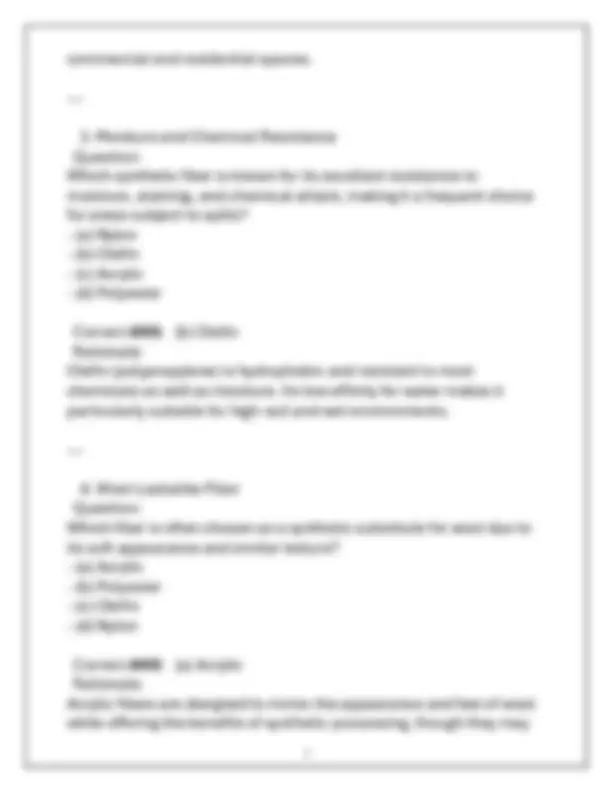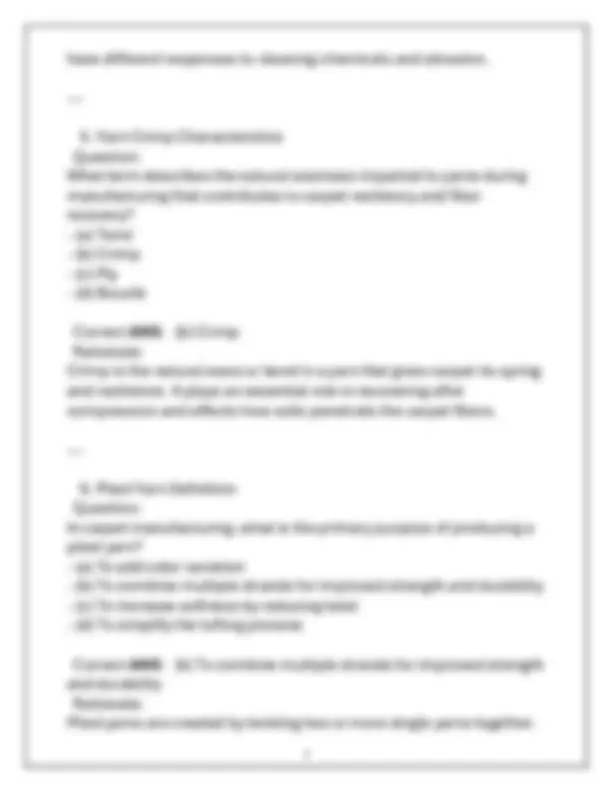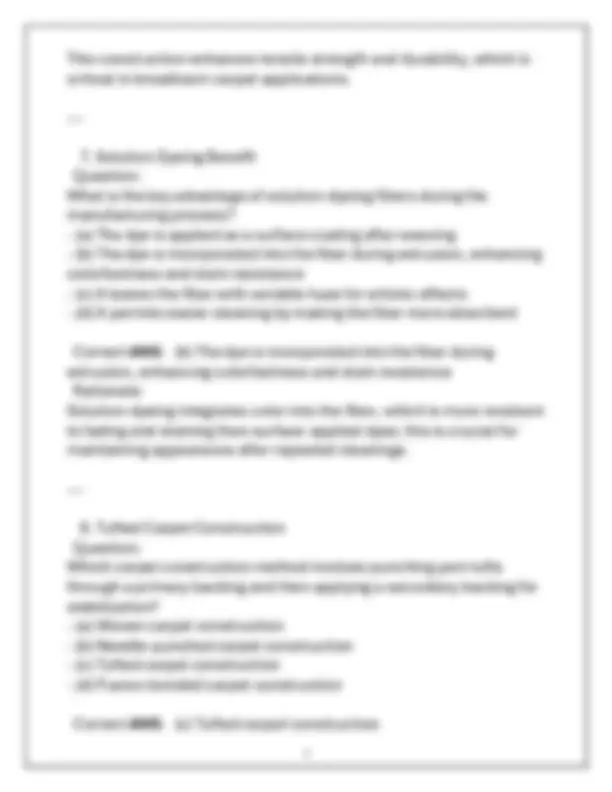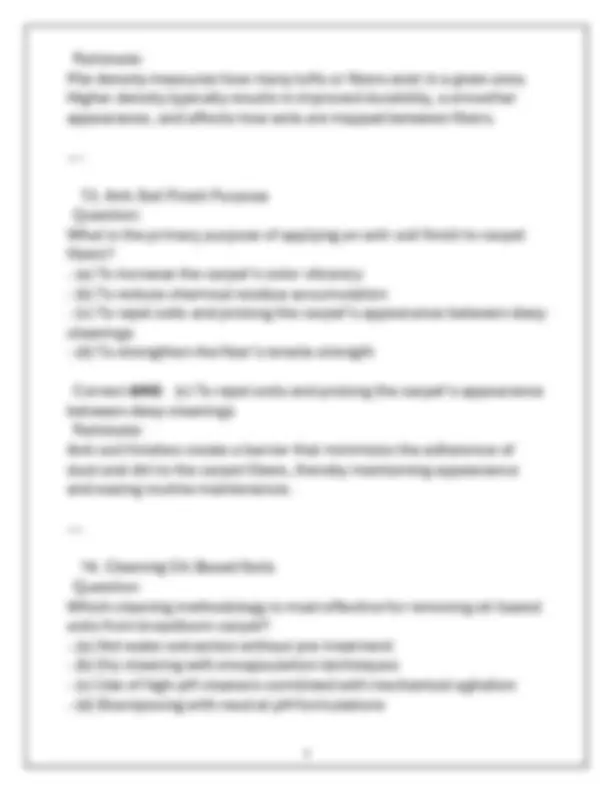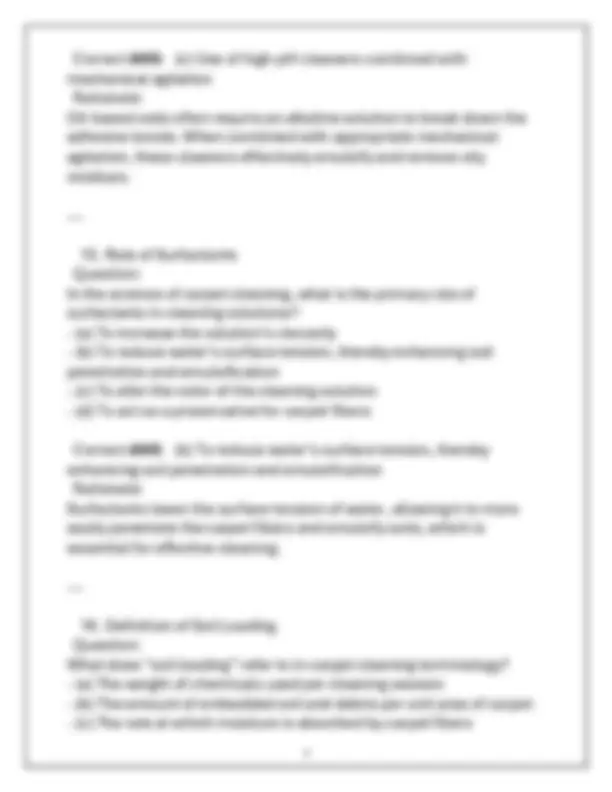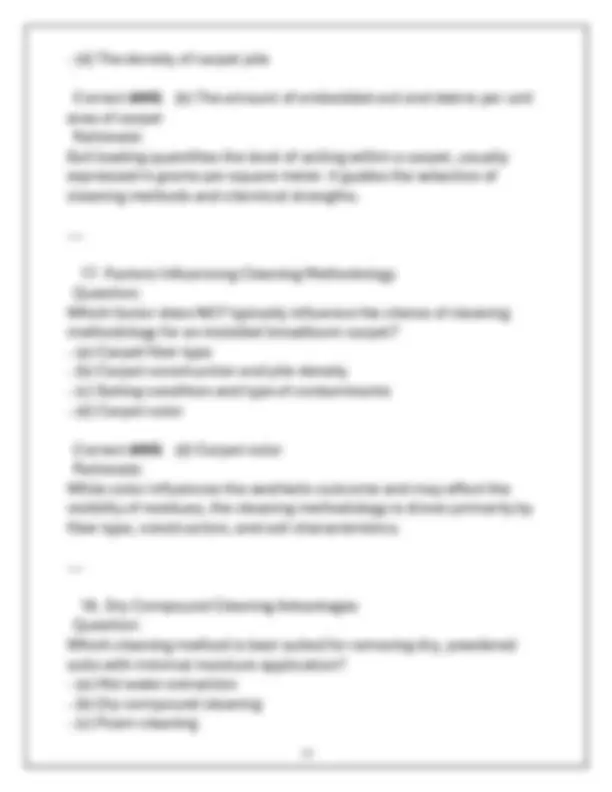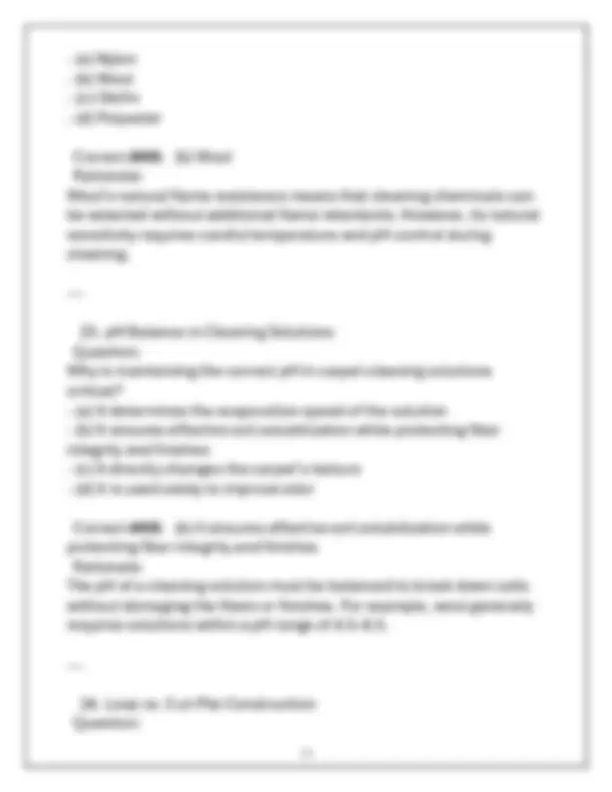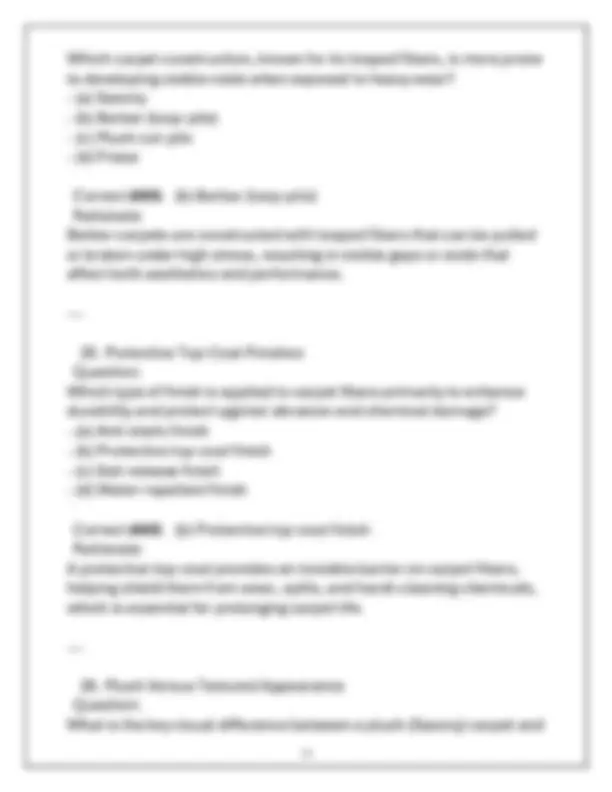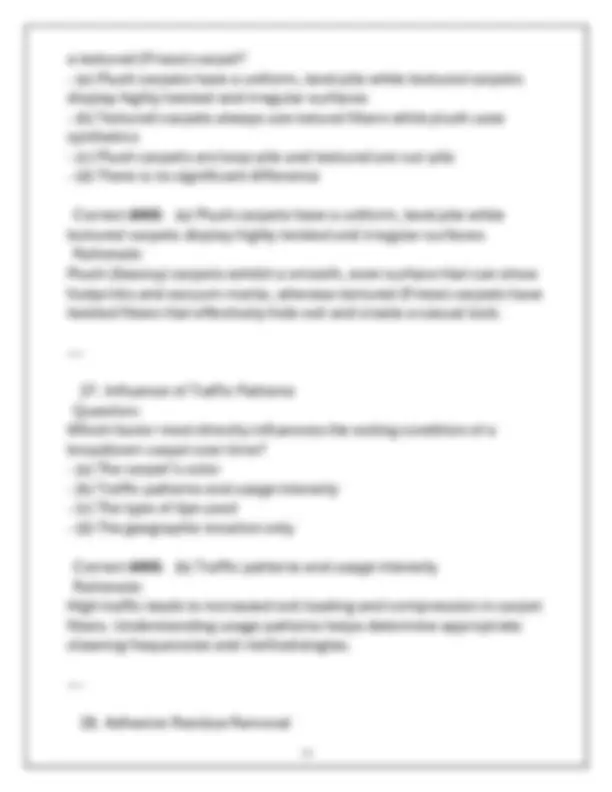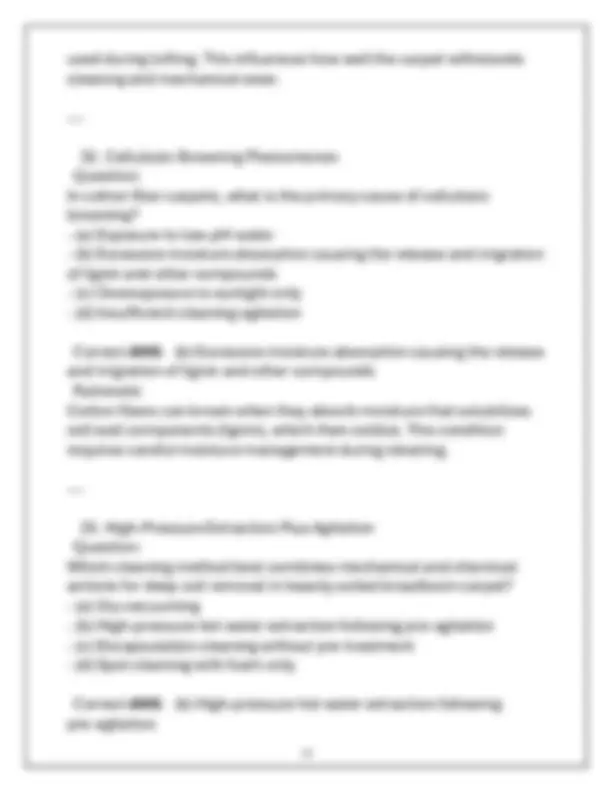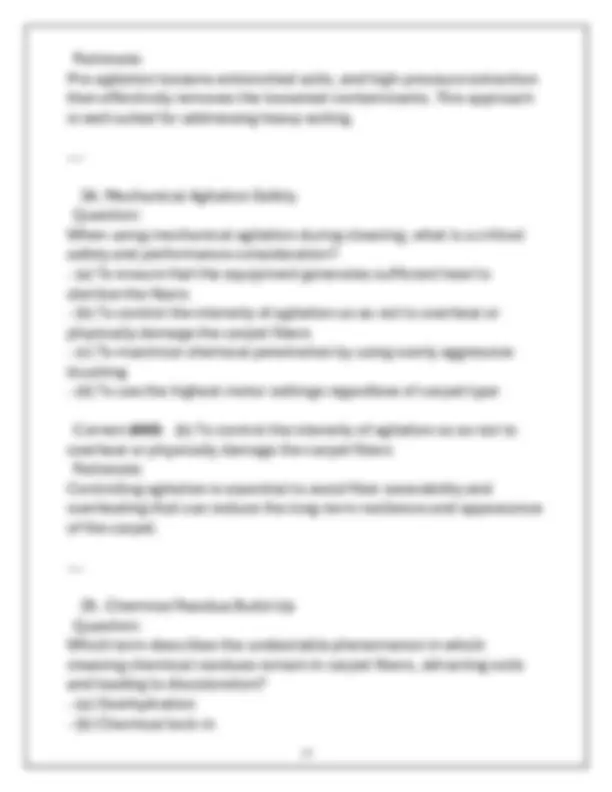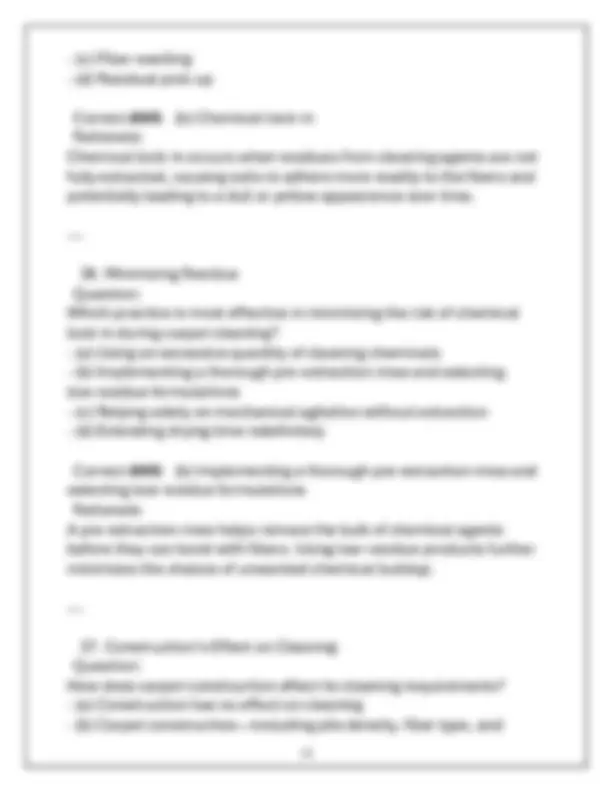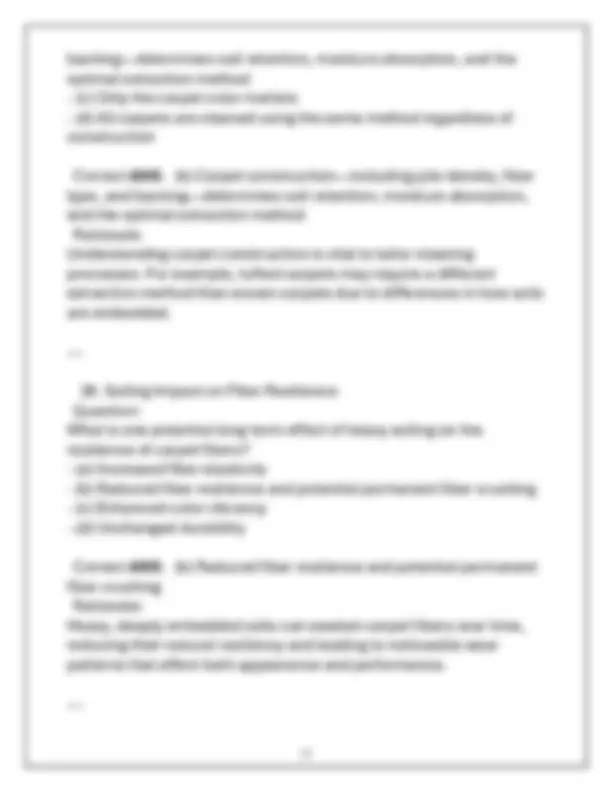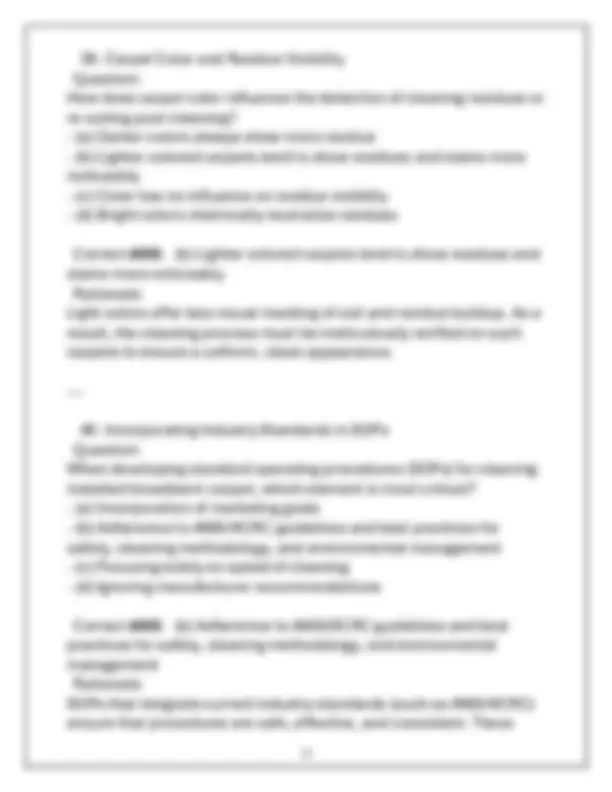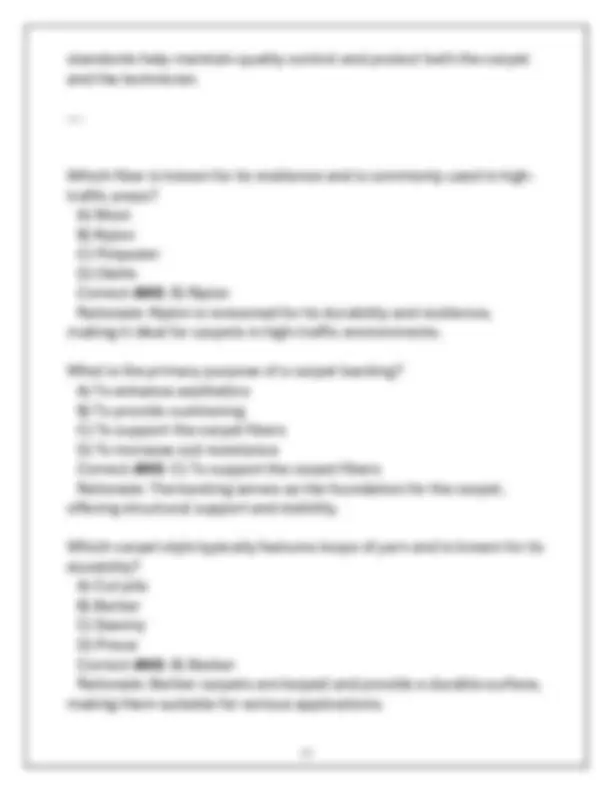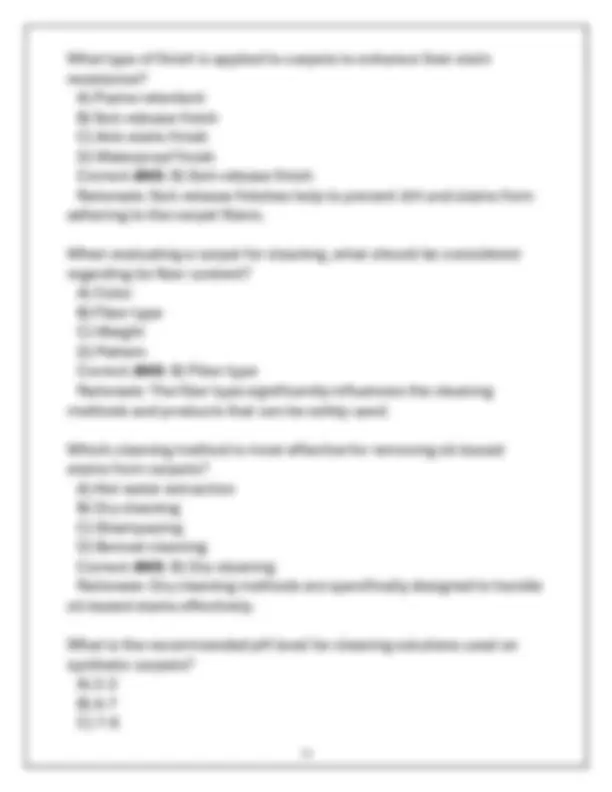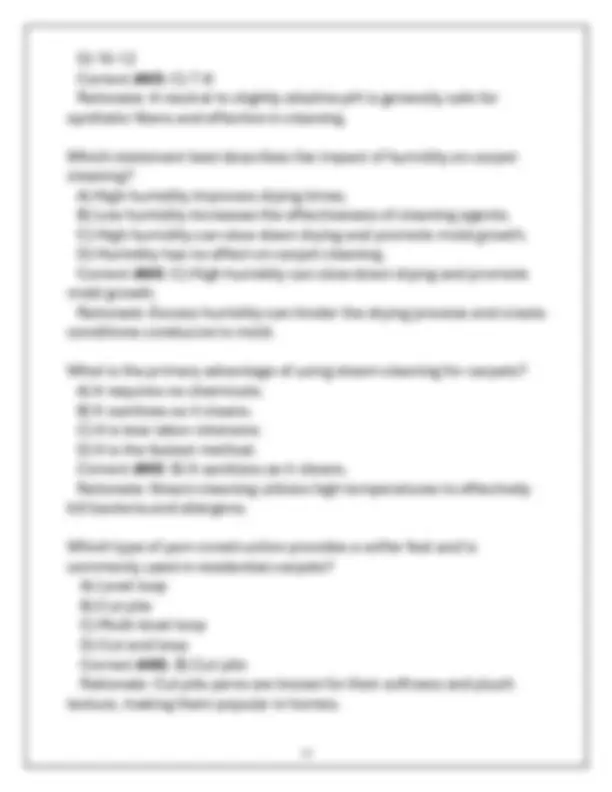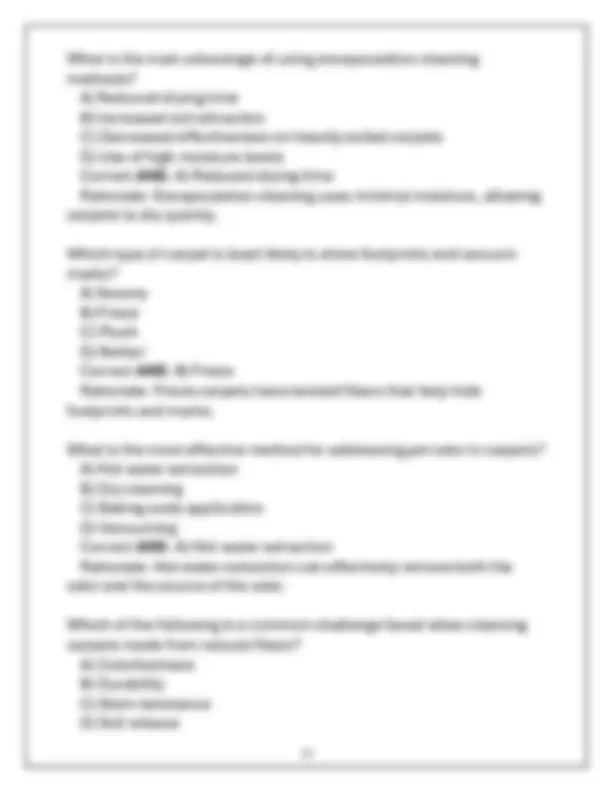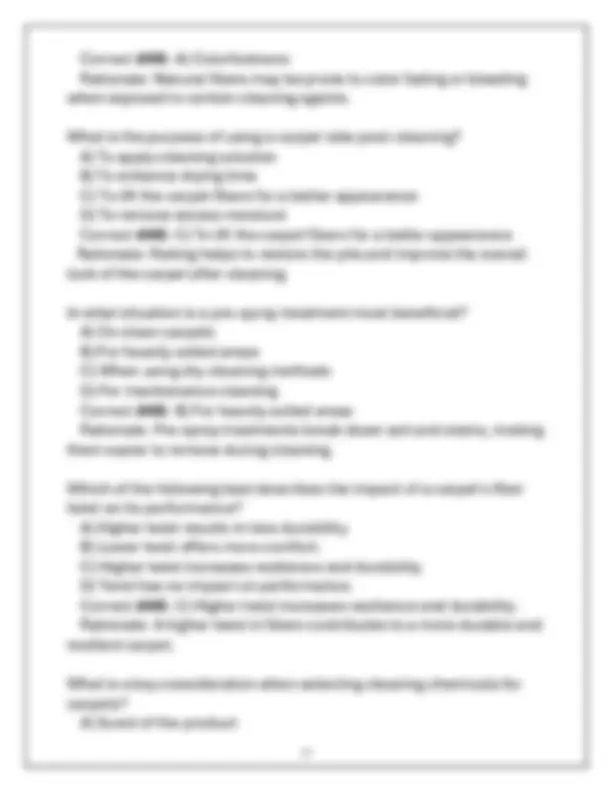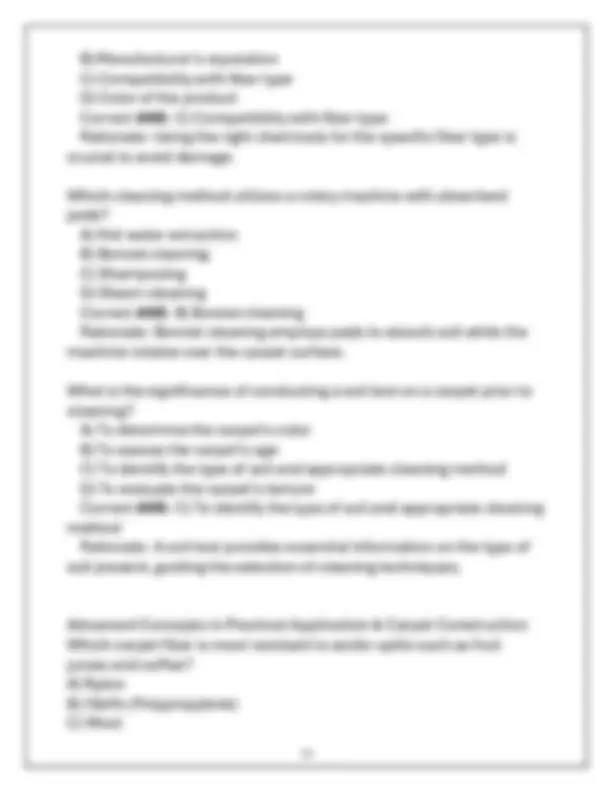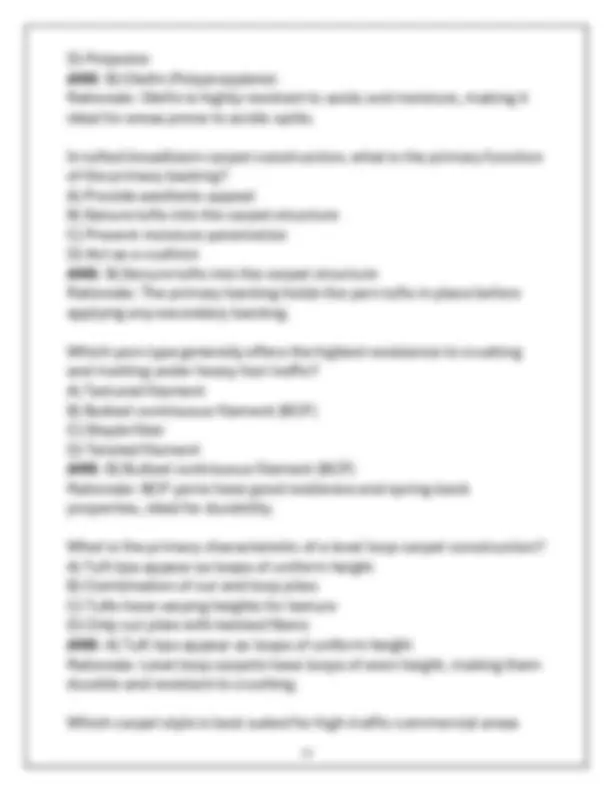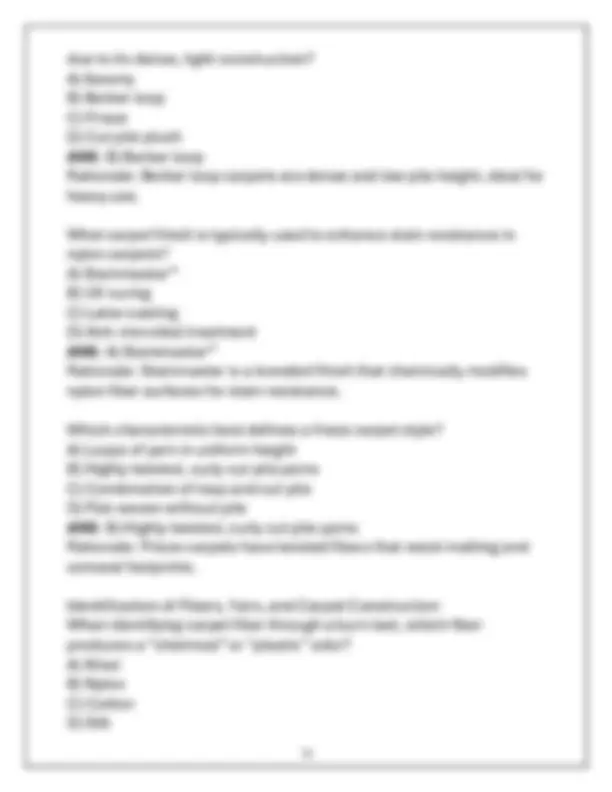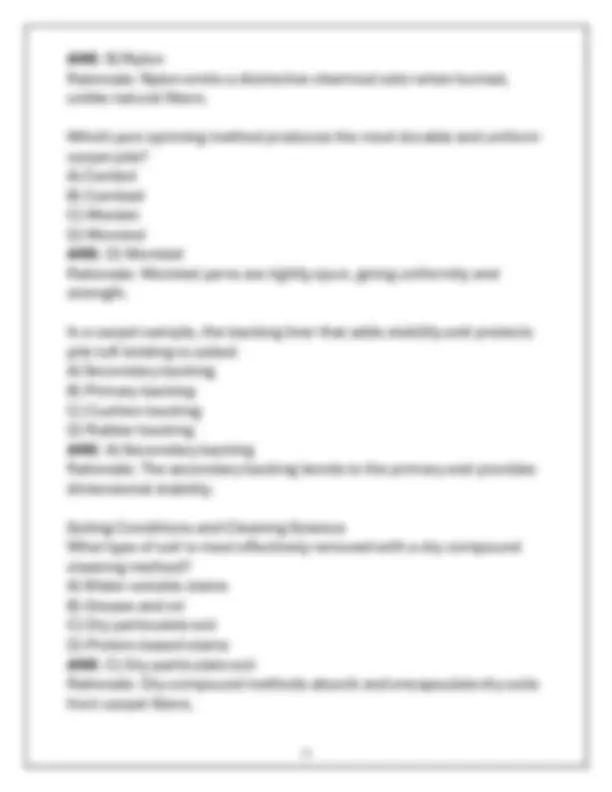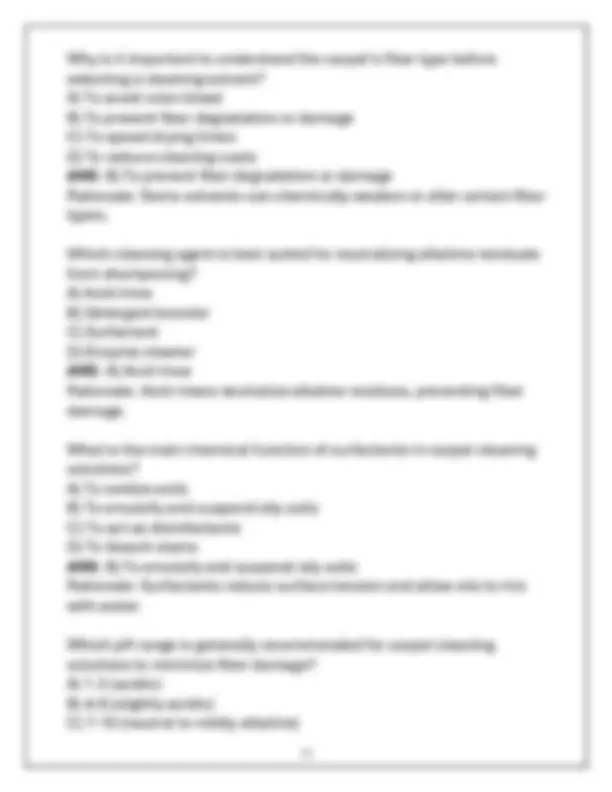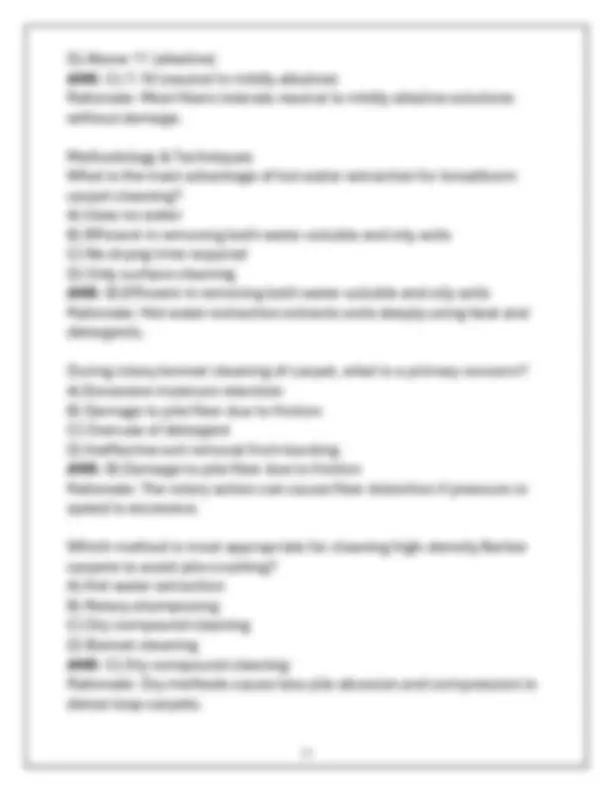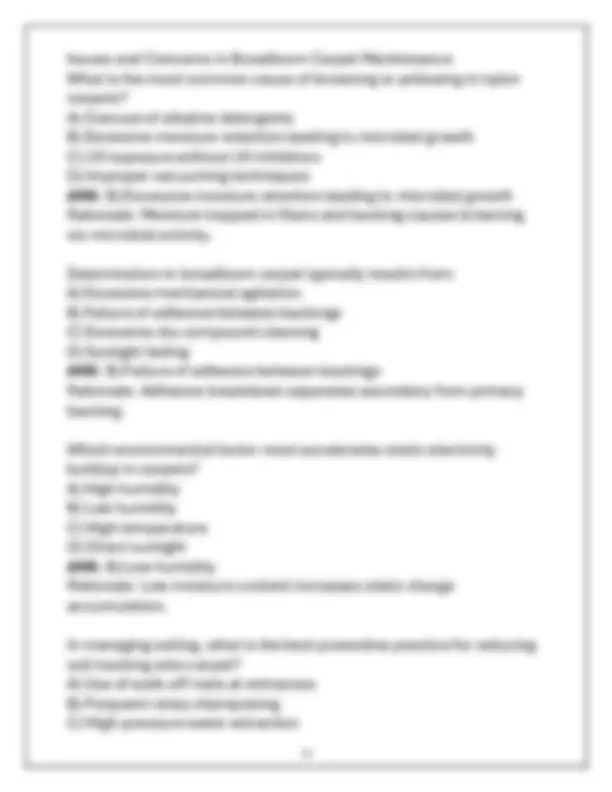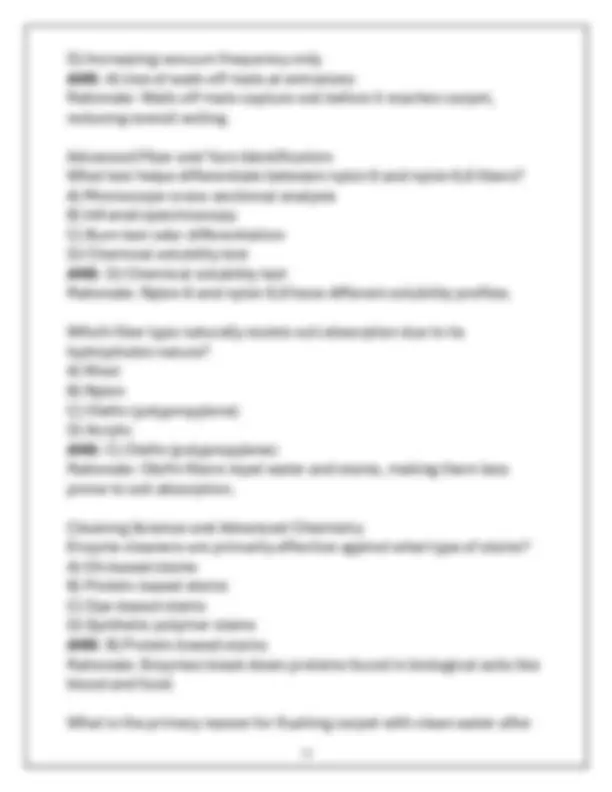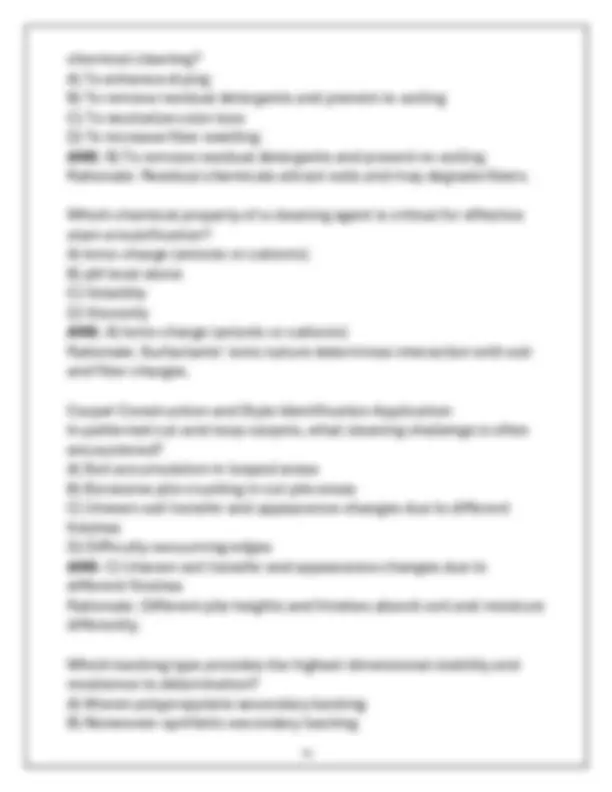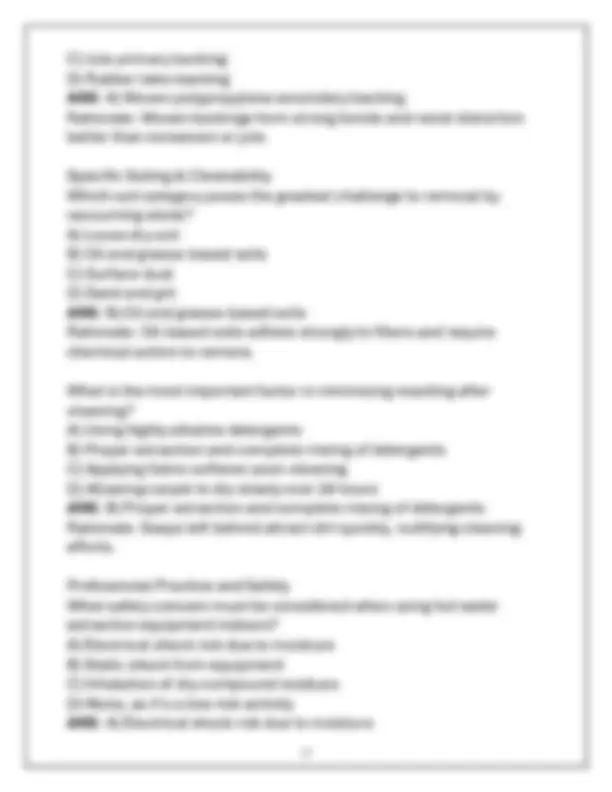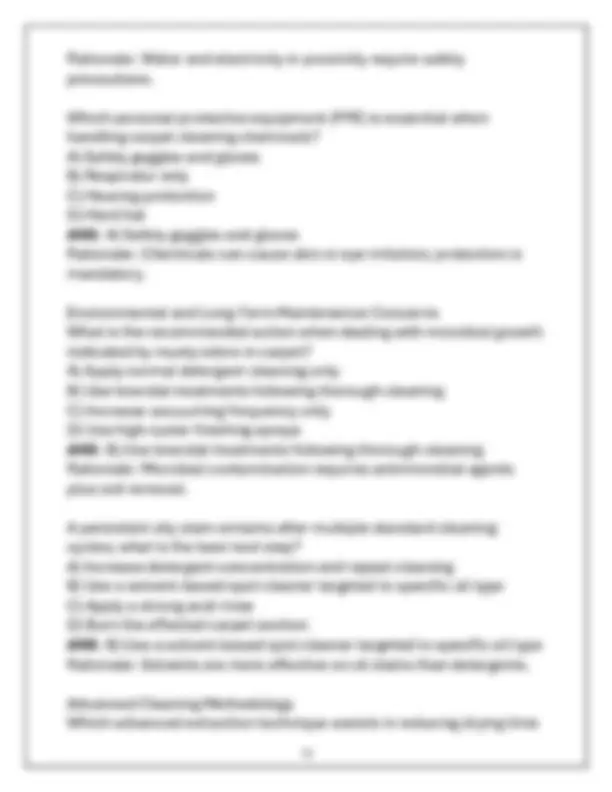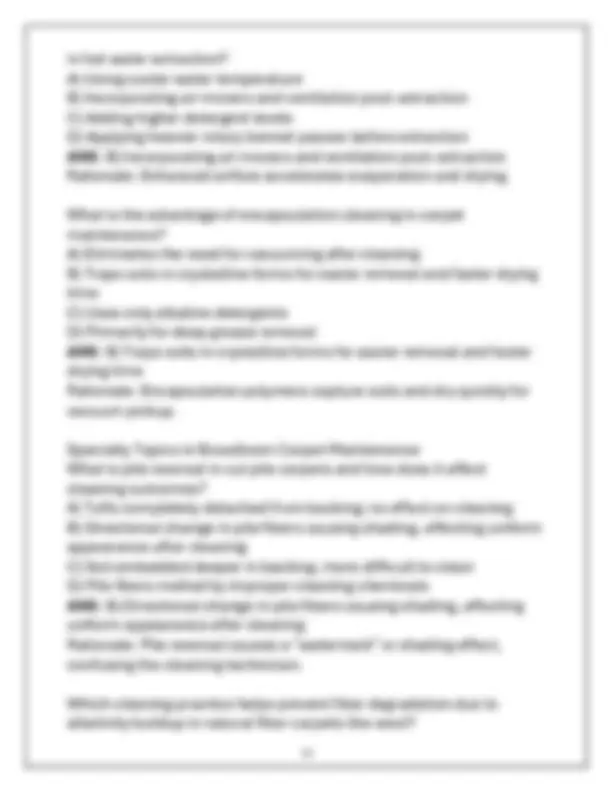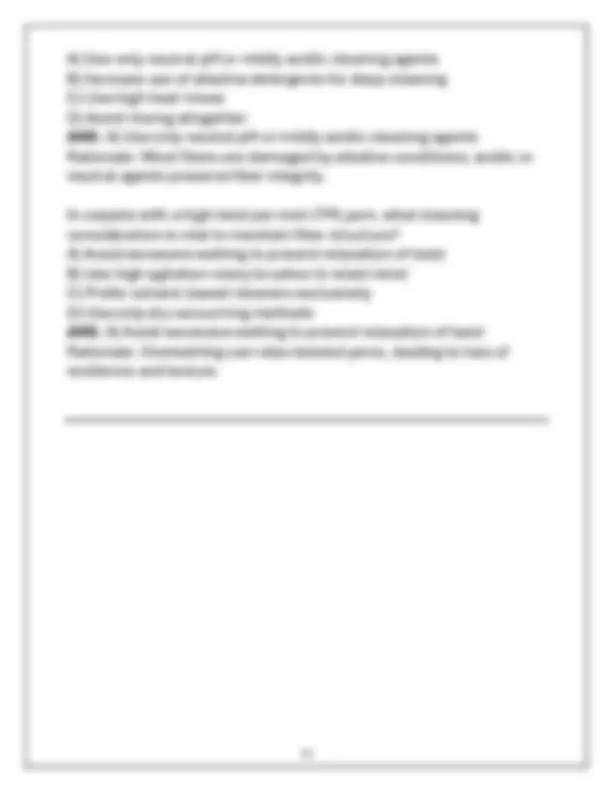Download Carpet Cleaning Technician Final Assessment Review 2025: Fiber Identification and Cleaning and more Exams Advanced Education in PDF only on Docsity!
Carpet Cleaning Technician
Final Assessment Review
(Questions & Solutions)
- Natural Fiber Identification Question: Which fiber is a natural protein fiber commonly used in high‑end carpet installations?
- (a) Nylon
- (b) Wool
- (c) Olefin
- (d) Acrylic Correct ANS : (b) Wool Rationale: Wool is a natural protein fiber known for its durability, resilience, natural flame resistance, and inherent soil‑hiding properties. Its cleaning requirements differ from synthetic fibers and must be handled at controlled pH and temperature levels.
- Synthetic Fiber Resilience Question: Which synthetic fiber is most popular for installed broadloom carpet because of its resiliency and soil‑resistance characteristics?
- (a) Polyester
- (b) Nylon
- (c) Acrylic
- (d) Olefin Correct ANS : (b) Nylon Rationale: Nylon is the most widely used synthetic carpet fiber due to its excellent resilience, high abrasion resistance, and ability to recover from compression. These qualities make it ideal for high‑traffic
have different responses to cleaning chemicals and abrasion.
- Yarn Crimp Characteristics Question: What term describes the natural waviness imparted to yarns during manufacturing that contributes to carpet resiliency and fiber recovery?
- (a) Twist
- (b) Crimp
- (c) Ply
- (d) Bouclé Correct ANS : (b) Crimp Rationale: Crimp is the natural wave or bend in a yarn that gives carpet its spring and resilience. It plays an essential role in recovering after compression and affects how soils penetrate the carpet fibers.
- Plied Yarn Definition Question: In carpet manufacturing, what is the primary purpose of producing a plied yarn?
- (a) To add color variation
- (b) To combine multiple strands for improved strength and durability
- (c) To increase softness by reducing twist
- (d) To simplify the tufting process Correct ANS : (b) To combine multiple strands for improved strength and durability Rationale: Plied yarns are created by twisting two or more single yarns together.
This construction enhances tensile strength and durability, which is critical in broadloom carpet applications.
- Solution Dyeing Benefit Question: What is the key advantage of solution‑dyeing fibers during the manufacturing process?
- (a) The dye is applied as a surface coating after weaving
- (b) The dye is incorporated into the fiber during extrusion, enhancing colorfastness and stain resistance
- (c) It leaves the fiber with variable hues for artistic effects
- (d) It permits easier cleaning by making the fiber more absorbent Correct ANS : (b) The dye is incorporated into the fiber during extrusion, enhancing colorfastness and stain resistance Rationale: Solution‑dyeing integrates color into the fiber, which is more resistant to fading and staining than surface‑applied dyes; this is crucial for maintaining appearance after repeated cleanings.
- Tufted Carpet Construction Question: Which carpet construction method involves punching yarn tufts through a primary backing and then applying a secondary backing for stabilization?
- (a) Woven carpet construction
- (b) Needle‑punched carpet construction
- (c) Tufted carpet construction
- (d) Fusion-bonded carpet construction Correct ANS : (c) Tufted carpet construction
Rationale: Saxony carpets are characterized by meticulously cut fibers that create a formal, uniform look but may show impressions or footprints, affecting cleaning choices and maintenance.
- Frieze Carpet Identification Question: What distinguishes a Frieze (or twisted cut‑pile) carpet from a Saxony carpet?
- (a) Frieze carpets are loop‑pile while Saxony are cut‑pile
- (b) Frieze carpets have a highly twisted, more textured surface that better masks soil
- (c) Frieze carpets use only synthetic fibers
- (d) There is no difference in construction Correct ANS : (b) Frieze carpets have a highly twisted, more textured surface that better masks soil Rationale: The heavily twisted fibers in Frieze carpets create a casual, textured appearance that provides excellent soil hiding and increased durability in heavy‑traffic areas.
- Pile Density Definition Question: What does “pile density” refer to in carpet construction?
- (a) The number of tufts or fibers per unit area
- (b) The thickness of the carpet backing
- (c) The total weight of the carpet per square yard
- (d) The amount of dye used in the fibers Correct ANS : (a) The number of tufts or fibers per unit area
Rationale: Pile density measures how many tufts or fibers exist in a given area. Higher density typically results in improved durability, a smoother appearance, and affects how soils are trapped between fibers.
- Anti-Soil Finish Purpose Question: What is the primary purpose of applying an anti‑soil finish to carpet fibers?
- (a) To increase the carpet’s color vibrancy
- (b) To reduce chemical residue accumulation
- (c) To repel soils and prolong the carpet’s appearance between deep cleanings
- (d) To strengthen the fiber’s tensile strength Correct ANS : (c) To repel soils and prolong the carpet’s appearance between deep cleanings Rationale: Anti‑soil finishes create a barrier that minimizes the adherence of dust and dirt to the carpet fibers, thereby maintaining appearance and easing routine maintenance.
- Cleaning Oil-Based Soils Question: Which cleaning methodology is most effective for removing oil‑based soils from broadloom carpet?
- (a) Hot water extraction without pre‑treatment
- (b) Dry cleaning with encapsulation techniques
- (c) Use of high‑pH cleaners combined with mechanical agitation
- (d) Shampooing with neutral pH formulations
- (d) The density of carpet pile Correct ANS : (b) The amount of embedded soil and debris per unit area of carpet Rationale: Soil loading quantifies the level of soiling within a carpet, usually expressed in grams per square meter. It guides the selection of cleaning methods and chemical strengths.
17. Factors Influencing Cleaning Methodology Question:
Which factor does NOT typically influence the choice of cleaning methodology for an installed broadloom carpet?
- (a) Carpet fiber type
- (b) Carpet construction and pile density
- (c) Soiling condition and type of contaminants
- (d) Carpet color Correct ANS : (d) Carpet color Rationale: While color influences the aesthetic outcome and may affect the visibility of residues, the cleaning methodology is driven primarily by fiber type, construction, and soil characteristics.
18. Dry Compound Cleaning Advantages Question:
Which cleaning method is best suited for removing dry, powdered soils with minimal moisture application?
- (a) Hot water extraction
- (b) Dry compound cleaning
- (c) Foam cleaning
- (d) Shampooing Correct ANS : (b) Dry compound cleaning Rationale: Dry compound cleaning involves working an absorbent compound into the carpet that binds with dry soils. The compound is then vacuumed out, making it ideal for areas where moisture use must be minimized.
19. High Pile Considerations Question:
What is the primary concern when cleaning a broadloom carpet with high pile density?
- (a) The carpet may release excessive fibers
- (b) Inadequate water extraction can lead to prolonged drying times and potential microbial growth
- (c) It requires less agitation than low‑pile carpets
- (d) It does not benefit from pre‑treatment protocols Correct ANS : (b) Inadequate water extraction can lead to prolonged drying times and potential microbial growth Rationale: High‑pile carpets trap more water and cleaning chemicals. Without proper extraction, residual moisture can lead to extended drying times and increased risk of mold formation.
20. Hot Water Extraction Safety Question:
Which safety concern is particularly important when using hot water extraction equipment on installed carpet?
- (a) Excessive chemical exposure
- (a) Nylon
- (b) Wool
- (c) Olefin
- (d) Polyester Correct ANS : (b) Wool Rationale: Wool’s natural flame resistance means that cleaning chemicals can be selected without additional flame retardants. However, its natural sensitivity requires careful temperature and pH control during cleaning.
23. pH Balance in Cleaning Solutions Question:
Why is maintaining the correct pH in carpet cleaning solutions critical?
- (a) It determines the evaporation speed of the solution
- (b) It ensures effective soil solubilization while protecting fiber integrity and finishes
- (c) It directly changes the carpet’s texture
- (d) It is used solely to improve odor Correct ANS : (b) It ensures effective soil solubilization while protecting fiber integrity and finishes Rationale: The pH of a cleaning solution must be balanced to break down soils without damaging the fibers or finishes. For example, wool generally requires solutions within a pH range of 4.5–8.5.
24. Loop vs. Cut‑Pile Construction Question:
Which carpet construction, known for its looped fibers, is more prone to developing visible voids when exposed to heavy wear?
- (a) Saxony
- (b) Berber (loop‑pile)
- (c) Plush cut‑pile
- (d) Frieze Correct ANS : (b) Berber (loop‑pile) Rationale: Berber carpets are constructed with looped fibers that can be pulled or broken under high stress, resulting in visible gaps or voids that affect both aesthetics and performance.
25. Protective Top‑Coat Finishes Question:
Which type of finish is applied to carpet fibers primarily to enhance durability and protect against abrasion and chemical damage?
- (a) Anti‑static finish
- (b) Protective top‑coat finish
- (c) Soil‑release finish
- (d) Water‑repellent finish Correct ANS : (b) Protective top‑coat finish Rationale: A protective top‑coat provides an invisible barrier on carpet fibers, helping shield them from wear, spills, and harsh cleaning chemicals, which is essential for prolonging carpet life.
26. Plush Versus Textured Appearance Question:
What is the key visual difference between a plush (Saxony) carpet and
Question: Sticky, adhesive‑like soils on carpet fibers often require which cleaning approach to break their bonds?
- (a) Low‑pH cleaning solutions only
- (b) High‑pH (alkaline) treatments combined with controlled mechanical agitation
- (c) Minimal agitation with cool water
- (d) No chemical pre‑treatment Correct ANS : (b) High‑pH (alkaline) treatments combined with controlled mechanical agitation Rationale: Adhesive residues typically respond better to alkaline solutions that break down their molecular bonds. The method must be carefully managed to avoid fiber damage.
29. Fiber Severability Concerns Question:
What does the term “fiber severability” refer to, and why is it important during cleaning?
- (a) It refers to the ease with which fibers are cut or damaged by overly aggressive cleaning equipment
- (b) It indicates how much water a fiber can absorb
- (c) It describes a fiber’s ability to return to its original shape
- (d) It is a measure of the fiber’s colorfastness Correct ANS : (a) It refers to the ease with which fibers are cut or damaged by overly aggressive cleaning equipment Rationale: If cleaning equipment is too aggressive, it may sever fibers, leading to permanent damage. Understanding fiber severability helps define the appropriate cleaning pressure and agitation levels.
- Soluble vs. Insoluble Soils Question: Why is it critical for technicians to discern between soluble and insoluble soils on carpet fibers?
- (a) Soluble soils are best removed with water‑based methods, whereas insoluble soils may require solvents or additional agitation
- (b) Insoluble soils always indicate a new soiling problem
- (c) Both types of soils are removed using identical methods
- (d) The distinction has no practical cleaning impact Correct ANS : (a) Soluble soils are best removed with water‑based methods, whereas insoluble soils may require solvents or additional agitation Rationale: Recognizing the chemical nature of soils enables technicians to select cleaning agents that effectively dissolve or dislodge contaminants without compromising the carpet fiber integrity.
- Tuft Bond Strength Influences Question: What factor most directly influences the tuft bond strength in a carpet?
- (a) The type and curing of the backing adhesive
- (b) The number of colors in the carpet
- (c) The fiber’s natural crimp
- (d) The ambient cleaning temperature Correct ANS : (a) The type and curing of the backing adhesive Rationale: The strength with which the carpet fibers are secured (tuft bond strength) depends on the quality and proper curing of the adhesive
Rationale: Pre‑agitation loosens entrenched soils, and high‑pressure extraction then effectively removes the loosened contaminants. This approach is well suited for addressing heavy soiling.
- Mechanical Agitation Safety Question: When using mechanical agitation during cleaning, what is a critical safety and performance consideration?
- (a) To ensure that the equipment generates sufficient heat to sterilize the fibers
- (b) To control the intensity of agitation so as not to overheat or physically damage the carpet fibers
- (c) To maximize chemical penetration by using overly aggressive brushing
- (d) To use the highest motor settings regardless of carpet type Correct ANS : (b) To control the intensity of agitation so as not to overheat or physically damage the carpet fibers Rationale: Controlling agitation is essential to avoid fiber severability and overheating that can reduce the long-term resilience and appearance of the carpet.
- Chemical Residue Build-Up Question: Which term describes the undesirable phenomenon in which cleaning chemical residues remain in carpet fibers, attracting soils and leading to discoloration?
- (a) Overhydration
- (b) Chemical lock‑in
- (c) Fiber swelling
- (d) Residual pick‑up Correct ANS : (b) Chemical lock‑in Rationale: Chemical lock‑in occurs when residues from cleaning agents are not fully extracted, causing soils to adhere more readily to the fibers and potentially leading to a dull or yellow appearance over time.
36. Minimizing Residue Question:
Which practice is most effective in minimizing the risk of chemical lock‑in during carpet cleaning?
- (a) Using an excessive quantity of cleaning chemicals
- (b) Implementing a thorough pre‑extraction rinse and selecting low‑residue formulations
- (c) Relying solely on mechanical agitation without extraction
- (d) Extending drying time indefinitely Correct ANS : (b) Implementing a thorough pre‑extraction rinse and selecting low‑residue formulations Rationale: A pre‑extraction rinse helps remove the bulk of chemical agents before they can bond with fibers. Using low‑residue products further minimizes the chance of unwanted chemical buildup.
37. Construction’s Effect on Cleaning Question:
How does carpet construction affect its cleaning requirements?
- (a) Construction has no effect on cleaning
- (b) Carpet construction—including pile density, fiber type, and

